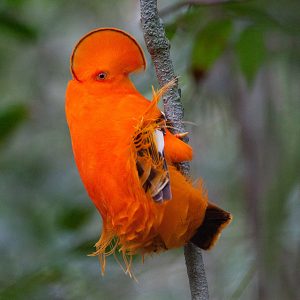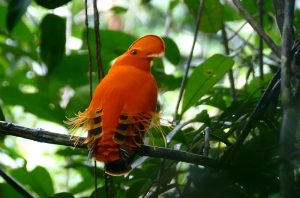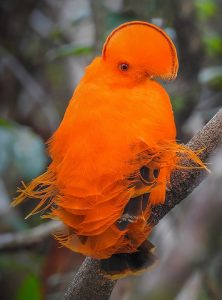An unmistakable, exquisite, captivating, oddly shaped bird, covered in bright orange plumage, with a striking half-moon crest.
MEET THE GUIANAN COCK-OF-THE-ROCK
View this post on Instagram
The Guianan cock-of-the-rock (Rupicola rupicola) is a species of cotinga, a passerine bird endemic to South America. The orange-plumed bird male has a very striking half-moon-shaped crest, along with a black-tipped tail. His wings are orange and white with silky-orange filaments on the inner remiges (birds flight feathers that are attached to the rear portion of the wing bones). Not to be outdone, his bill, legs, and skin are also orange.
View this post on Instagram
Much less conspicuous than the male, the female is a dark shade of brown and grey.
Related Reading:
–15+ Captivating birds, so unusually beautiful, that might as well be from another planet!
She has a yellow-tipped black bill and a smaller crest than the male.

This species is found in the ancient mountains east of the Andes and north of the Amazon River, in the Guianas, and neighboring countries of Venezuela, Brazil, and Colombia.

The Guianan cock-of-the-rock like to live in humid forests near rocky outcrops where they dine on fruit and berries However, they will sometimes eat insects if their main source of food is scarce.
View this post on Instagram
During the breeding season, the males build a communal lek to put on a display to attract females. Once a female has selected a male and mating has been completed, the male’s role is over. The female builds a nest under a rocky overhang plastered to the rock with mud into which she lays one to two white eggs. She incubates her eggs for about 28 days and goes on to raise the hatchlings on her own.

Due to this species’ extremely large range, its current population does not approach the thresholds for Vulnerable under the range size criterion set by the ICUN.
WATCH THIS BIRD RIGHT HERE ON THE VIDEO BELOW:
Please SHARE this story with your friends and family.



